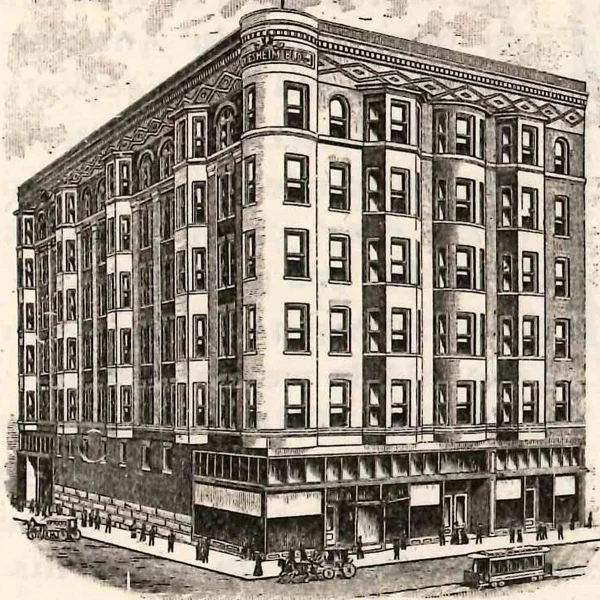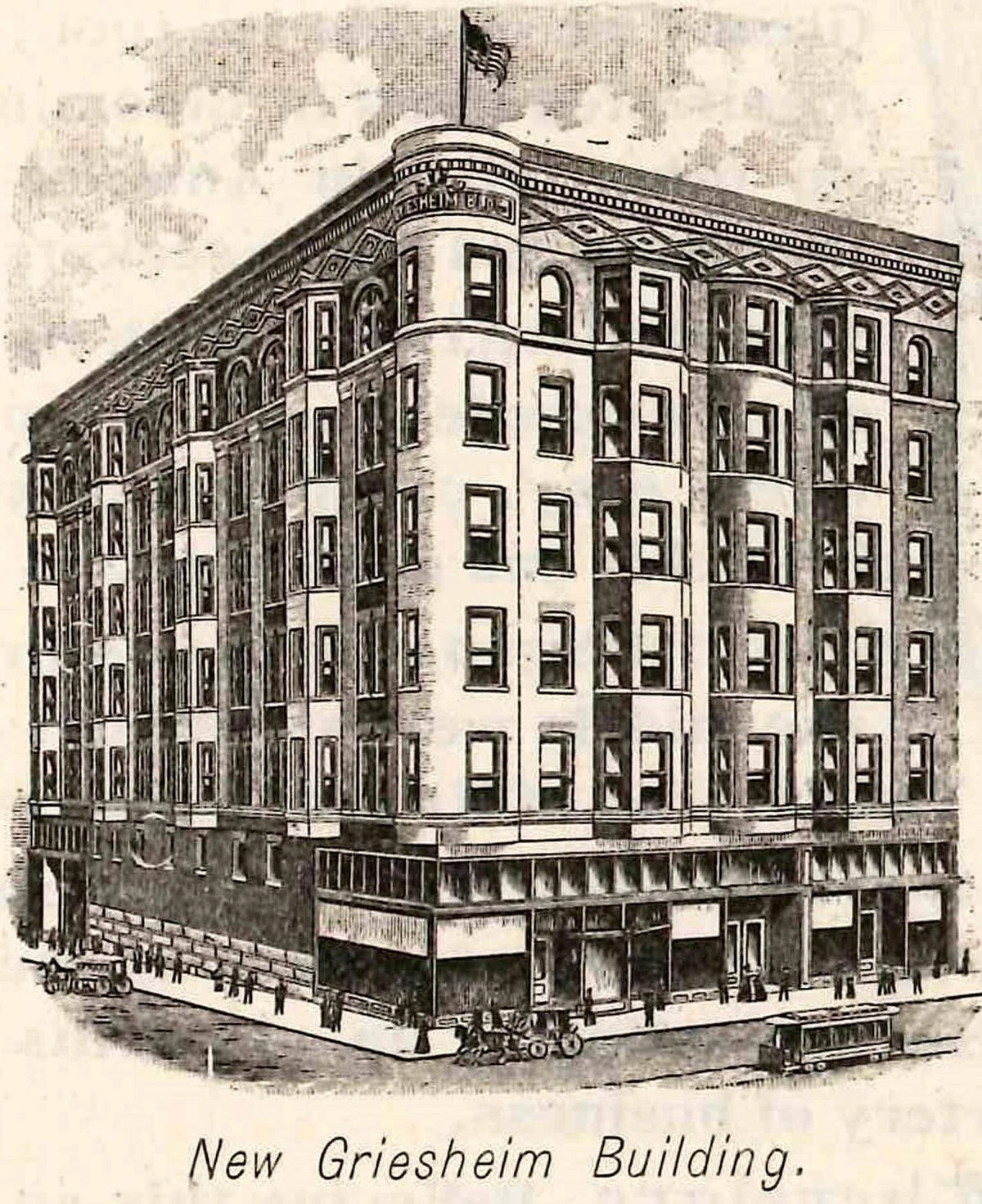The holiday season of 1900 brought more changes than usual for area shoppers flocking to downtown Bloomington.
A little more than six months earlier, on the night of June 19, 1900, a fire that began in the Model Laundry building on East Monroe Street quickly spread south and westward engulfing, in a few cataclysmic hours, 45 buildings and reducing 4½ square blocks of downtown to smoking rubble. Losses included the original Wolf Griesheim clothing store and office building, one of the larger downstate commercial buildings of its kind; dozens more retailers both large and small; the supposedly “fireproof” McLean County Courthouse built in 1868; and the Windsor, the city’s largest hotel.
With the arrival of the holiday season a large swath of downtown Bloomington resembled a construction site. Even so, the “burnt district” included a fair number of completed or nearly completed buildings, which meant there was surprisingly little disruption for downtown shoppers during the first Christmas after the Great Bloomington Fire.
A traveling salesman from St. Louis stopped in Bloomington on Nov. 30 on his first visit to the “Evergreen City” (Bloomington’s once-popular nickname) since the fire. “He was astonished at the immense amount of building that was going on at the present time,” reported The Pantagraph. “He said that he believed there was not another city in the country the size of Bloomington where as much energy would be displayed after a catastrophe of the kind that visited this city June 19.”
The new six-story Griesheim Building, located on the site of its burned-out predecessor at Main and Jefferson streets, was almost finished by the holiday season. A formal opening of the building was held Dec. 11, though much work continued on the floors of professional offices above the street-level retail space.
In a way the fire proved fortuitous in that modern commercial buildings, some featuring steel framing and large plate glass storefronts, replaced those that were lost to the flames. As such, Bloomington architects George H. Miller and Arthur L. Pillsbury played a leading role reshaping downtown for the 20th century.
According to one estimate, something like 12 to 14 million bricks from local manufacturers went into rebuilding downtown during the summer of 1900. Finer, high-quality brick from St. Louis and elsewhere, shipped by rail to Bloomington, was mainly used for the outer “courses” (or layers) of the walls. The more inexpensive local brick was used for the inner courses.
By Dec. 17, workers had finished the ornate terra cotta frieze and decorative cornice of the Col. D.C. Smith Building, 313 N. Main St. (it’s home to several art galleries today.) With this work complete the entire block of 300 North Main Street, running from Jefferson to Monroe, was now rebuilt—a mere six months removed from the Great Fire.
Downtown remained a hive of construction activity late into the holiday season. On Dec. 23, carpenters were busy putting in the joists on the second floor of the Braley Building, located at the corner of Center and Jefferson streets (Maguire’s Bar & Grill occupies the first floor today).
It was this tireless pace of reconstruction that made the 1900 Christmas season a success. “Merchants are pretty well satisfied with the amount that has come into their doors,” reported The Pantagraph on Christmas Eve. “There has been generous buying, and depleted stocks of goods are the rule, not the exception.”
The Pantagraph took a crack at estimating the amount of money spent in the Twin Cities on holiday gifts and “feastings,” and in doing so conservatively figured $2.50 for every man, woman and child. Although that seems like a trifle, $2.50 in inflation-adjusted dollars is the equivalent of more than $70 today.
Come to think of it … maybe that isn’t so much after all, at least compared to the hyper-consumerism of today!
“The day comes but once a year,” The Pantagraph said of Christmas back in 1900, “and the joys of it will more than balance the depleted pocketbooks and upset stomachs on the morrow.”
Christmas Day brought picture-perfect weather, at least as far as Santa and his reindeer were concerned. “The day was a typical one for the season,” noted The Pantagraph, “being cold and crisp, with snow falling at frequent enough intervals to remind one of winter’s reign.”
The city did not roll up its sidewalks for Christmas, which fell on a Tuesday that year. Some shops opened for several hours in the morning to accommodate panicky buyers, though candy stores kept their doors open for much of the day. U.S. letter carriers worked until 9:30 a.m., while Bloomington & Normal Railway employees kept the intercity streetcars running from the pre-dawn to late evening hours. Likewise, many telephone and telegraph operators faced the regular “weekday grind.”
McLean County Sheriff George Johnson’s wife Carrie was probably busier than most on Christmas Day, seeing that she provided a home-cooked turkey dinner for all jail inmates. Prisoners also received three cigars, a handkerchief, candy, popcorn, nuts and a card signed by the Johnsons wishing them a merry Christmas and happy New Year.
Yes, downtown was back one half year after the Great Fire, though there was still much work to do. Three days after Christmas, masons laid the first stone for the walls of the new courthouse. Formal dedication would come on Sep. 24, 1903. Today, this magnificent building, which remains the heart of historic downtown, is home to the McLean County Museum of History.
Back in 1900, the big local news was the Christmas Day arrest in Chicago of “Bloomington Red,” a notorious thief known for his taste in expensive silks (as in stealing—rather than wearing—them.) “Red,” who employed various aliases but whose real name was said to be John Murray, was wanted in Ottawa and Quincy, Ill.; Elkhart and LaPorte, Ind.; Beloit and Janesville, Wis.; Dubuque, Ia.; and other locales near and far. Bloomington served as his base of operations for quite a while, though during his time here he was known as “Red Summers.”
When arrested in Chicago, Bloomington Red had some $3,000 worth in silks pilfered during his recent foray to Quincy, as well as a roll of nine $100 bills in his pocket (or the equivalent of about $26,000 today). “He had evidently come to Chicago to celebrate the holiday season,” it was said.

